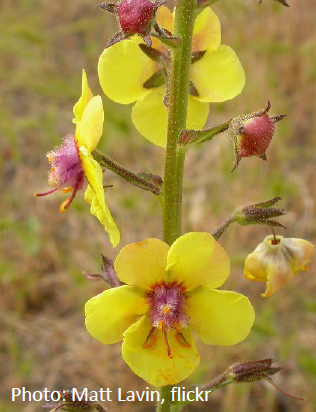NATIVE OR NON-NATIVES?
Reprinted with permission from the Gallatin Conservation District newsletter.
By Audra Bell
Recently, Gallatin County has experienced significant growth. Unfortunately, many newcomers to the county lack in-depth knowledge about the local plant and animal species. This became evident through a recent Facebook post from someone interested in buying an invasive bush for landscaping. In response, we decided it is important to talk about the plant ecosystems in Gallatin County and how non-native plants impact the landscape.
To fully understand how these plants were introduced, let's take a step back in time. The 1800s was a period of extensive exploration, as people of European descent traveled and settled in the western United States. The establishment of new settlements in the West led to the adoption of new agricultural practices, ideas, industries, and plant species. About 5,000 plant species have been introduced in the United States (USFS) and many of these species were introduced during that time. The introduction of these plant species took place through the transportation of hay and grains, as well as intentional introduction through ornamental flower gardens.
For instance, dalmatian toadflax and yellow toadflax are bright yellow flowering plants with similar flowers resembling a snapdragon. These toadflax variations were initially introduced to Montana as ornamental flowers for the Old Faithful and Lake Hotel in Yellowstone. Soon after, these delicate flowers were planted all over the state. However, these widespread toadflax varieties have now been classified as noxious weeds by the state and pose a threat to native plant species.
Yellow Toadflax, https://www.gardenia.net/plant/linaria-vulgaris [gallatincd.us19.list-manage.com]
Native plants offer numerous advantages over introduced or non-native species. These plants have adapted over time to the local climate, which reduces the need for human intervention such as watering, fertilizing, and pesticide use. Additionally, native plants have deep root systems, contributing to soil stability during runoff events, while introduced plants often have shallow root systems that can lead to erosion and competition with other plants leading to monoculture stands of weeds. Native plants also promote biodiversity and provide easier forage for livestock and wildlife compared to many invasive weed species. Considering these factors is essential while considering plants for landscaping or cutting for floral arrangements.
In Montana, invasive species have been ranked based on their prevalence and the threat they pose to the ecosystem. In Gallatin County, there has been an increasing population of invasive plants, prompting a deep dive into a few of the heavy hitters.
The first introduced plant species we will cover is the Russian Olive tree/bush. Back in the 1900s, this hardy plant was brought in to serve as windbreaks and provide wildlife habitat for ungulates and upland birds. Recognizable by its long, narrow, and silvery-mealy leaves, the Russian Olive can grow as a small tree or a bush. It's commonly found along river corridors and near old growth cottonwood stands. Once established, Russian Olive can outcompete native grasses and young cottonwood trees. In fact, Russian Olives are considered a high-priority invasive species in the state and are illegal to spread or sell in Montana!
Russian Olive, https://www.kdnk.org/news/2018-04-11/removing-all-of-the-olives-russian-olives-that-is [gallatincd.us19.list-manage.com]
The invasive plant we are going to explore next is Houndstongue. This plant, which was first identified in Montana in 1900, likely made its way to the United States through contaminated grain seeds. Houndstongue is easily recognizable by its thick stem adorned with striking burgundy flowers and large rounded, hairy leaves. The teardrop-shaped seeds have a velcro-like texture and readily attach to anything that comes into contact with the plant, making them easily dispersed. This species is notorious for displacing native plants and lead to a monoculture of weeds. Houndstongue is toxic to livestock and is not favored by wildlife. It thrives in areas where the ground has been recently disturbed and has spread throughout the Montana landscape.
Leafy spurge, another plant of concern in Gallatin County, was originally brought to the United States in the 1800s as an attractive ornamental plant. Its distinctive light green and yellow leaves and small berry-like bulb make it easy to identify. Found in grasslands, meadows, and river corridors, leafy spurge is highly competitive and has the ability to displace native plants, much like the Russian olive and hound tongue. This invasive plant exhibits high genetic variability, which enables it to thrive in various climate conditions.
Let's talk about some invasive grasses: cheatgrass, medusahead, and ventenata. These species were introduced unintentionally. Cheatgrass is prevalent in Montana and can be recognized by its sharp seedpod and the rusty color it takes on in late summer. Medusahead, less common in Gallatin County, can be identified by its long-spiked seedpods. Ventenata is a newer species to Gallatin County and is recognized for its short, spiked seedpod. All of these grasses are highly competitive and can outcompete native plant species.
Gallatin County residents are lucky to have a wide range of local resources available for plant identification, purchasing, and technical guidance. When it comes to technical questions, there are several excellent resources to turn to, including the Gallatin Conservation District (GCD), Gallatin County Weed District, and Montana State University Extension (MSU Extension). As caretakers of Montana's natural beauty, it is essential to champion the preservation of native plant life.


Moth Mullein
Moth mullein (Verbascum blattaria) is a biennial forb native to Eurasia that was found in North America as early as 1818, likely introduced for ornamental or medicinal uses. Occurrences of moth mullein in Montana have increased over the last 10-12 years, especially in western Montana. Its cousin, common mullein (Verbascum thapsus), is more recognizable and even on several Montana counties’ noxious weed list.
Moth mullein is not a noxious weed in Montana, but it is a restricted species in Colorado. Moth mullein is widely distributed across the U.S. and Canada and opinions about it range from “pretty wildflower” to invasive weed. Continue reading...
|
|